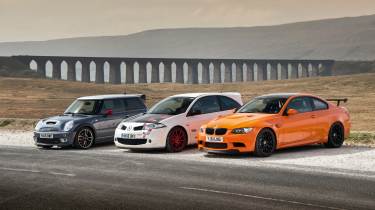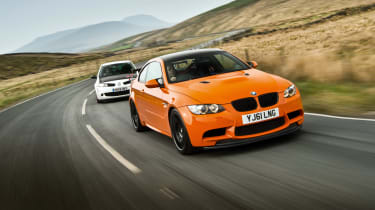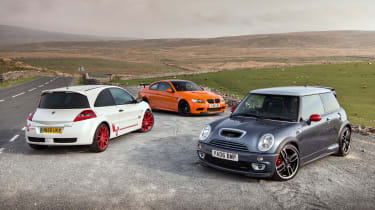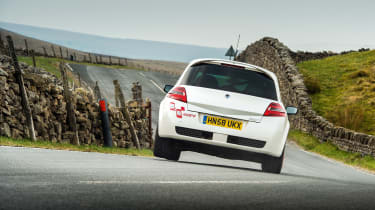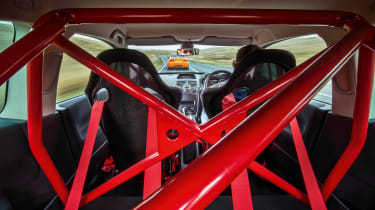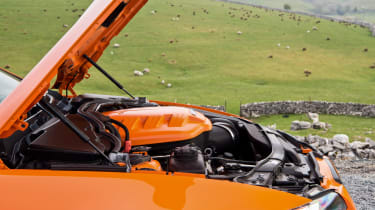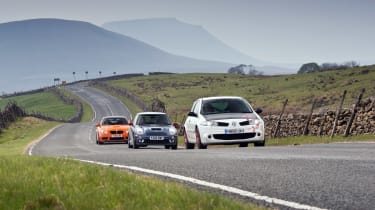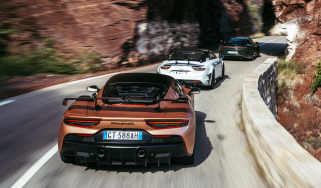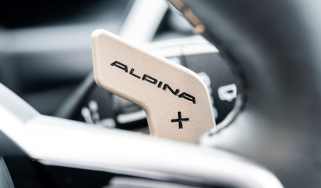BMW M3 GTS vs Mini GP vs Renault Sport Mégane R26.R
You could spend £250,000 on a 700bhp hardcore machine, but is there just as much fun to be had – if not more – with less power and for less outlay?
It’s often said that racing drivers have a special capacity to remove their brains on a qualifying lap or when driving bumper-to-bumper in persistent rain and blinding spray. The suggestion being that to engage in this type of thing requires you to ignore logical thought, to erase fear of personal injury. To live only in the moment. Sounds romantic and heroic in the context of racing, doesn’t it? Death or glory and all that stuff…
But what about on the road? I only ask because the painful truth is that to enjoy new supercars to their full potential requires you to leave your brain at home, pretend that residing at Her Majesty’s pleasure on occasion is ‘a nice little break’, and treat other cars as back-markers that must be dispatched as quickly as possible. Don’t get me wrong, I love many of these cars, but even in an office full of diehard enthusiasts the group test you’ve perhaps already read involving Pista, 720S, SVJ and GT3 RS came to be known as ‘the prison test’ in preceding editorial meetings. Brains definitely not required.
> Renaultsport Megane R26.R (2009) review - an all-time great hot hatch
Which brings us to these cars. They hold the very same things dear: lightweight engineering, highly polished dynamics, raw feedback and pure driving thrills. But not only are they more attainable from a financial point of view (even the rare and wildly expensive M3 GTS) but also so much more accessible in terms of performance and dynamics. They encourage you to think. About momentum and corner speed, about wringing everything from their engines and deconstructing a road piece-by-piece rather than in one dizzying lunge. They make you think other things, too. Like… ‘Hmm, how much is an R26.R these days?’ Or, ‘I’m sure I could make a standard E92 M3 drive like this with a few choice tweaks…’
So welcome to the Community Service test. We have the ‘20 hours’ Mini Cooper S Works GP, which can be yours from as little as £8750 on the used market, the ‘50 hours’ Renault Sport Mégane R26.R, available from £18,000, and the ‘100 hours and maybe some day-release’ BMW M3 GTS, which are still fetching over £150,000. I suppose people who can afford that will have good legal representation, so maybe we’ll call it the ‘hefty fine and a slap on the wrist’.
Our mission today is to re-examine these terrific cars by 2019 standards, have an awful lot of fun and discover whether the sharpest, angriest, most lunatic-fast driver’s cars of today can still learn a trick or two from these not-so-old icons. I guess the evo collective thinks of these sorts of cars as a sweet spot between extreme and usable… but maybe we’re wrong. Maybe things have moved so fast that they simply feel a bit old and clunky. Colleagues involved in the Pista group test are mostly in hiding somewhere in international waters, but Antony Ingram is fresh from the test and here to provide some context.
So far has the Mini brand strayed from the die cast during its initial relaunch that it seems hard to imagine the scene that the first Mini Works GP was launched into in 2006. The feisty, lightweight and super-agile R53 Mini had become the darling of the tuning scene and every day another remap, small supercharger pulley conversion and suspension kit was released. The Cooper S chassis could handle plenty of power and had all the ingredients to make an effective trackday car, and the aftermarket was making a fortune exploiting that potential. BMW wanted a slice of the pie.
> Mini John Cooper Works GP review: Best of 2013
This, the Works GP, was its solution, and in common with the R26.R and M3 GTS it didn’t concern itself too much with huge headline power figures. The 1.6-litre four-cylinder supercharged engine got a small boost over the John Cooper Works kit to 215bhp at 7100rpm and 184lb ft at 4600rpm, but the magic was in the lightweighting and the chassis. Andreas Decher, leader of the chassis validation team, wasn’t shy about their efforts. ‘Think of it as a baby M-car,’ he said. ‘Maybe even a CSL.’
Out went the rear seats, in their place a large metal brace cum luggage restraint behind the front seats. There were unique aluminium control arms for the rear suspension (saving 7.5kg per side) and lighter wheels (2kg per corner), contributing to a weight saving of 50kg and a total of just 1090kg. Suspension was 10mm lower and retuned, while the deeper splitter, extended side sills and carbonfibre rear spoiler created a bit of downforce, too. People questioned the £22,000 price tag at the time, but limited to just 2000 units and with so much proper engineering thrown at the ‘baby CSL’, the extra £2880 it commanded over a regular Cooper S Works seems pretty decent value.
It sounds rather obvious to say it, but the GP looks and feels tiny. Back in ’06 Dickie Meaden described Mini’s new head-banger as ‘smothered in crass decals, glitzy detailing and awkward-looking aerodynamic addenda’, but I think he was just having a bad day. In 2019 it looks aggressive but clean and features some cool, tongue-in-cheek details and a ride height that looks seriously purposeful.
Inside it’s not all so rosy. The stalks feel so brittle, the leather on the fat steering wheel slimy and cheap and the squishy Recaros seem a bit half-hearted. However, the way you can ratchet the driver’s seat way down low and the sharp-sided glasshouse that gives great visibility ensure a fantastic driving environment. And even the most cynical will find it hard not to smile when you glance at the empty space behind you. Twist the key and the humble 1.6-litre four fires up with a gruff bark and the whole car seems to tingle with energy.
I’d expected freakishly sharp turn-in and a busy, nervous rear end from the GP but first impressions are rather different. Yes, it feels light and pointy but because the car rides so flat and exhibits real stability at the rear, the steering’s rate of response seems perfectly intuitive and beautifully in sync with the chassis. The ride is firm but doesn’t fight the surface as it does in the nutty GP2 (from 2013 and based on the R56-generation Mini). There’s just enough compliance to parry bumps, and those lightweight wheels help the tyres trace the surface with precise control. Rather than being frenetic and nervy, the GP shows real poise.
While the chassis is alert but with an underlying calmness, the engine adds a welcome splash of manic character. It whines and thrashes and the supercharger noise takes on a properly feral scream as the revs rise, amplified by the cavernous hole where you’d expect to find seats and also by the removal of sound-deadening material. The supercharger solution makes a cool noise, then. But it also gives a strong, linear power delivery and is another tool in picking apart the road ahead. It never shocks the front wheels and gives the limited-slip differential a fair crack at deploying all the available torque.
The GP really does duck and dive across the ground at a formidable pace and the front end feels really hooked into the surface. Traction is fantastic, there’s very little discernible torque-steer and mid-corner it hangs on for dear life. It’s particularly enjoyable through faster turns, where front and rear tyres seem to be working equally hard and generating a deliciously neutral stance.
I guess my only niggling concern is that the GP feels fast and focused but almost too mannered. It doesn’t have the raw intensity that the specification suggests, nor the outright agility you expect in slower and medium-speed turns. The front-end grip is there but sometimes the rear feels just a shade imprecise. You can help point the car into turns by lifting the throttle during the run-in phase but the GP tends to roll lazily into oversteer rather than flick neatly and cleanly to the desired angle. It’s fun but there’s just a slight layer of stodge that seems at odds with the tight damping, accurate front end and rabid little engine. The brakes could be stronger, too. Even so, the Works GP really is a little firecracker of a hot hatch.
Once the shock of not having 700bhp to play with dissipates, Antony finds much to like in the GP too. ‘Amazing how much smaller it feels than the current Mini,’ he says. ‘Its agility feels inherent to how compact and light it is rather than just a function of quick steering. The gearknob is ridiculously large, but the shift is sweet, and the engine’s a joy.’
However, the GP isn’t the only thing Antony has found to his liking. He’s just hopped out of the bug-strewn R26.R and the lingering smell of hot brakes and tyres tells me he’s had plenty of fun. ‘Been wanting to drive one on the road for some time,’ he says with a big grin, ‘and it’s as good as I’d hoped. Supple, controlled, as quick as you’d want a hot hatchback to be, dripping with feedback. Just one of the greatest front-drivers ever, isn’t it?’
There’s something deeply cool about the R26.R’s basic plastic dash and door mouldings. They really do look cheap and scratchy and light. And that’s the key. Renault really, really wanted the R26.R to be a kind of ultimate. The ultimate version of their clunkily named Renault Sport Mégane 230 F1 Team R26, certainly. The ultimate hot hatch. The ultimate trackday car. Maybe the ultimate front-wheel driver of all time. So it went to extraordinary lengths, including those cheaper fittings from poverty-spec models, a radio delete, reduced sound-deadening, the removal of the rear seats, lightweight carbon-shelled Sabelt seats up front, a carbonfibre bonnet, plastic side windows and rear screen, a thinner exhaust (the optional titanium system was an extra £2250), removal of the front fog lamps, manual mirror adjustment… and so it goes on.
The result is a rather spectacular weight saving of 125kg for a total of 1220kg, and retuned springs and dampers that are actually less extreme than the standard car’s due to the significant diet. Power from the 2-litre turbocharged engine was unchanged at 227bhp with 229lb ft. Back in ’08 Renault UK decided to take 230 of the total production run of 450 and priced the R26.R at £23,815. Sadly about 12 minutes later the world’s economy collapsed. In the end 159 were sold in right-hand drive and the total run was cut short to just 364 units.
Here and now on a warm spring day, skimming over a road that heaves and sighs across the Yorkshire Dales, the thought that a car this outrageously good was available for less than £25,000 (in fact they were heavily discounted) and didn’t find an audience seems surreal, tragic and frustrating. There’s just so much quality. The thin-rimmed steering wheel is just right and the clean, low-effort rack seems so suited to the way this car goes about its business. It’s not quite as alert as the Mini initially, but there’s so much more bite and such is the body control that the bigger-boned Mégane manages to feel even lighter than the GP.
Much of that is to do with the damping. Where the Mini starts to buck, weave and show signs of unravelling, the R26.R is just getting going. It’s a shade firmer than I remember, but even though you feel exactly what the surface is doing it has literally no effect on the speed you can carry across it. Just point and shoot and marvel at the composure and revel in the noises and sensations. The optional barely treaded Toyo R888 tyres hum and whistle, the blast-furnace exhaust is wickedly angry, the six-speed ’box is a joy to use and the whole car zings with enthusiasm.
Unlike some of the old front-drive heroes, the R26.R is not an arch lift-off oversteerer. Instead it’s laser-guided and absolutely hooked-up. Think of it as a locked-down tarmac rally car rather than an hyper-agile Super Tourer. Control needn’t mean inert though, and in the quick stuff the way the rear takes on just a trace of yaw and helps you stay committed to the throttle is scintillating stuff. To balance quite high grip levels with this much progression at the limit is amazing.
To throw the R26.R at a corner, immediately jump on the power and feel the diff magically pull the car towards the apex so effectively that you have to unwind the steering lock is to understand just how incredibly exciting a well-sorted front-driver can be. It’s a dazzling hot hatch and although it’s nowhere near as fast as, say, a new Civic Type R, it really doesn’t matter. It’s such a perfectly formed whole that rueing that you need to take second in tight corners rather than riding a fat torque curve in a higher gear is missing the point.
The quality that I love most about the R26.R is that it gets better the harder you go and pretty soon you find yourself punching in gearshifts like a lunatic, howling through clear-sighted corners, thwacking the rev-limiter and going in hot enough to have the tyres chirruping under braking. It almost demands such treatment. Rather incredibly, so does the BMW M3 GTS. They really are cut from the same cloth. Carbonfibre, naturally.
Of course, when you talk about the M3 GTS it’s hard to get away from the question of value. Despite stroking the E92 M3’s V8 out to 4361cc (up from 72.5mm to 82mm) and stripping out rear seats, using plastic for the quarter windows and rear screen, fitting a titanium exhaust and a whole host of other tricks, the M3 GTS just doesn’t stack up on paper. The new engine has 444bhp (just 30bhp more than the standard car) and the GTS weighs 70kg less, but it’s still a portly 1530kg. Oh, and in 2010 it was priced at £117,630 when an M3 Competition was £55,365 and a 997.2 GT3 was a barely believable £81,914. Just 135 GTSs were built.
It takes about five minutes to put all of that stuff out of your mind. Things start well as soon as you open the door and see the prosaic interior with a couple of bucket seats (complete with slapped-on FIA certification), a big orange roll-cage, a fire extinguisher and not much else. It has the same no-bullshit vibe as the R26.R. Then you settle in, slot the oblong key into a slot to the left of the steering wheel and press the starter button. The V8 howls for a second and then throbs a deep, resonant tune through the titanium silencers. No heaped-on V8 drama here. The GTS sounds this way because, well, it sounds this way.
First gear hits home with a thunk and the M DCT ’box almost feels like it’s got straight-cut gears as you creep away in a series of ugly jolts. The M Differential is unrecognisable, too. Banging and clonking and dragging wheels as you manoeuvre, just like a race car in the paddock. There’s such mechanical connection and you don’t need to be told the rear subframe is now solidly mounted. You feel it. You feel everything.
At speed that feedback loop is amplified until you can paint a picture in your mind’s eye of the rear tyres being smudged into the road surface. The steering is wonderfully feelsome and such is the confidence it brings that you tend to drive the GTS a little like the R26.R – steering aggressively into corners knowing it’ll stick and then pouring power into the mix quickly to load up the rear axle. The GTS will oversteer everywhere and do so with staggering poise, but in fact it prefers to be driven precisely, each Pirelli teetering on the edge and providing the most amazing sense that you’re getting everything out of the chassis.
The engine, despite its increased stroke, is an absolute screamer and makes a fabulously pure noise. It’s just a part of the sensory overload but you’d do well to pay attention, because as the note tightens and grows in intensity so you’ll feel the engine’s effects on that solidly mounted rear suspension, too. Hands, eyes, ears… everything is engaged in the GTS and each message seems perfectly consistent with the next to provide the driver with every last morsel of information to exploit the car’s many talents.
Weak points? The dual-clutch ’box isn’t as instant as a new Ferrari of Porsche equivalent, the six-piston brakes are good but not outstanding compared to a ceramic-shod GT3, but in terms of pure entertainment the M3 GTS stands comparison with pretty much anything. And it does it all on ‘only’ 444bhp. Imagine that.
It’s fascinating to drive M3 GTS and R26.R back-to-back as they really do feel related. Cars developed and honed by people who really care, and sadly cars that too few people will ever get the chance to enjoy. These cars – and the brilliant Mini Works GP to only a slightly lesser extent – prove beyond doubt that you can experience an ‘ultimate’ without strapping yourself to a rocket-sled; that immersion and outright performance are linked but that involvement doesn’t always follow the upward trend of power and torque curves; that accessibility through a combination of lower limits and enhanced driver feedback is a drug every bit as addictive as experiencing a 700, 800 or even 1000bhp supercar at full flight. These cars aren’t old and clunky. They’re pure, enthralling and proof positive that chasing out weight is more effective than chasing power when it comes to making a great driver’s car.
BMW M3 GTS
| Engine | V8, 4361cc |
| Power | 444bhp @ 8300rpm |
| Torque | 324lb ft @ 3750rpm |
| Weight | 1530kg |
| Power-to-weight | 295bhp/ton |
| 0-62mph | 4.4sec |
| Top speed | 190mph |
| Price new | £117,630 (2010) |
| Value now | £150,000+ |
Mini Cooper S Works GP
| Engine | In-line 4-cyl, 1598cc, supercharger |
| Power | 215bhp @ 7100rpm |
| Torque | 184lb ft @ 4600rpm |
| Weight | 1090kg |
| Power-to-weight | 200bhp/ton |
| 0-62mph | 6.5sec |
| Top speed | 149mph |
| Price new | £22,000 (2006) |
| Value now | £8750-13,000 |
Renault Sport Mégane R26.R
| Engine | In-line 4-cyl, 1998cc, turbo |
| Power | 227bhp @ 5500rpm |
| Torque | 229lb ft @ 3000rpm |
| Weight | 1220kg |
| Power-to-weight | 189bhp/ton |
| 0-62mph | 6.0sec |
| Top speed | 147mph |
| Price new | £23,815 (2008) |
| Value now | £18,000-26,000 |
This feature first appeared in evo issue 262. To read the latest issue head to Mags Direct, or subscribe to make sure you don’t miss the next.

